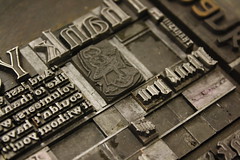 The Shakespeare Press Museum is a 19th working letterpress museum at Cal Poly, San Luis Obispo (California, USA). The museum is maintained by volunteer student curators who are assisted by a faculty adviser.
The Shakespeare Press Museum is a 19th working letterpress museum at Cal Poly, San Luis Obispo (California, USA). The museum is maintained by volunteer student curators who are assisted by a faculty adviser.The museum began as the private collection of Charles "Shakespeare" Palmer, who donated his collection of presses and type to Cal Poly in 1964. The museum has been open at Cal Poly since 1969. You can learn more about our founder here.
What do you mean by "19th century working letterpress museum?"
 The primary function of the museum is to serve as a repository for printing equipment that was used between 1850 and 1920 in California. Our collections include many different types of printing presses, many different fonts of type, and additional equipment and tools that are necessary to staff a printing office.
The primary function of the museum is to serve as a repository for printing equipment that was used between 1850 and 1920 in California. Our collections include many different types of printing presses, many different fonts of type, and additional equipment and tools that are necessary to staff a printing office.But in addition to serving as a museum we also function as a letterpress printing office. We believe that providing visitors with the opportunity to perform the act of printing provides a vital link to better understanding the experiences of the past. We provide students, university staff, and community members with the opportunity to learn printing, circa 1880.
Where is the museum? Can I visit?
The museum is located at Cal Poly, San Luis Obispo on California's Central Coast in Building 26, Room 116. You can find an interactive map of Cal Poly here.
The student curators open the museum regularly, however, these hours change from quarter to quarter depending on course schedules. If you are interested in visiting, please contact us at shakespearepress@gmail.com for our current open hours. We also provide tours to large groups, provided we receive advanced notice.
What exactly is letterpress printing?
 Letterpress printing is a form of relief printing, in which a reversed and raised surface of text and image is inked and then pressed into a sheet of paper using a printing press (think of a giant self-inking stamp). Letterpress printing is one of the oldest forms of printing, popularized by Johannes Gutenberg in the mid-fifteenth century. Between the 1450s and the 1950s letterpress printing was the primary way text and images were reproduced for books, newspapers, and all printed matter. In the later half of the twentieth century different printing processes, most notably offset lithography, replaced most letterpress printing. Now, in the twenty-first century, letterpress printing persists among printing enthusiasts, artists' bookmakers, stationers, and other aficionados of the industry. We've put together a list of videos showcasing letterpress printing if you would like to see printing presses in action. You might also check out our flickr page to see more images of the museum and our work.
Letterpress printing is a form of relief printing, in which a reversed and raised surface of text and image is inked and then pressed into a sheet of paper using a printing press (think of a giant self-inking stamp). Letterpress printing is one of the oldest forms of printing, popularized by Johannes Gutenberg in the mid-fifteenth century. Between the 1450s and the 1950s letterpress printing was the primary way text and images were reproduced for books, newspapers, and all printed matter. In the later half of the twentieth century different printing processes, most notably offset lithography, replaced most letterpress printing. Now, in the twenty-first century, letterpress printing persists among printing enthusiasts, artists' bookmakers, stationers, and other aficionados of the industry. We've put together a list of videos showcasing letterpress printing if you would like to see printing presses in action. You might also check out our flickr page to see more images of the museum and our work.Please explore our site! If you have any questions send us an email at shakespearepress@gmail.com.

